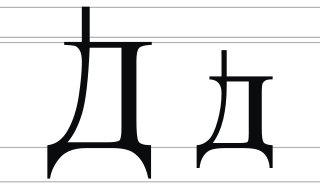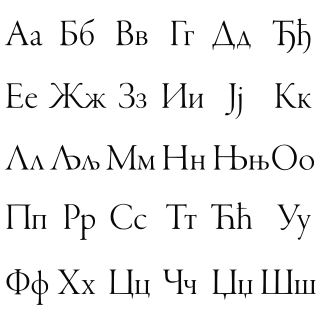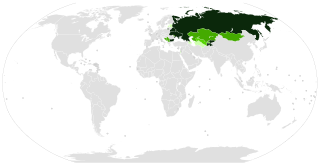
The Cyrillic script is a writing system used for various languages across Eurasia and is used as the national script in various Slavic, Turkic, Mongolic and Iranic-speaking countries in Southeastern Europe, Eastern Europe, the Caucasus, Central Asia, North Asia and East Asia.
Transliteration is a type of conversion of a text from one script to another that involves swapping letters in predictable ways, such as Greek ⟨α⟩ → ⟨a⟩, Cyrillic ⟨д⟩ → ⟨d⟩, Greek ⟨χ⟩ → the digraph ⟨ch⟩, Armenian ⟨ն⟩ → ⟨n⟩ or Latin ⟨æ⟩ → ⟨ae⟩.

W, or w, is the 23rd and fourth-to-last letter of the modern English and ISO basic Latin alphabets. It usually represents a consonant, but in some languages it represents a vowel. Its name in English is double-u, plural double-ues.

Kazakh, or Qazaq, is a Turkic language of the Kipchak branch spoken in Central Asia. It is closely related to Nogai, Kyrgyz and Karakalpak. Kazakh is the official language of Kazakhstan and a significant minority language in the Ili Kazakh Autonomous Prefecture in Xinjiang, China and in the Bayan-Ölgii Province of Mongolia. Kazakh is also spoken by many ethnic Kazakhs through the former Soviet Union, Germany, Turkey.

Kyrgyz, also spelled as Kirghiz, Kirgiz and Qirghiz, is a Turkic language of the Kipchak branch spoken in Central Asia. Kyrgyz is the official language of Kyrgyzstan and a significant minority language in the Kizilsu Kyrgyz Autonomous Prefecture in Xinjiang, China and in the Gorno-Badakhshan Autonomous Province of Tajikistan. There is a very high level of mutual intelligibility between Kazakh and Kyrgyz.

A unisex name is a given name that is not gender-specific. Unisex names are common in the English-speaking world, especially in the United States. By contrast, some countries have laws preventing unisex names, requiring parents to give their children sex-specific names. In other countries or cultures, social norms oppose such names and transgressions may result in discrimination, ridicule, and psychological abuse.

Cyrillization or Cyrillisation is the process of rendering words of a language that normally uses a writing system other than Cyrillic script into the Cyrillic alphabet. Although such a process has often been carried out in an ad hoc fashion, the term "cyrillization" usually refers to a consistent system applied, for example, to transcribe names of German, Chinese, or English people and places for use in Russian, Ukrainian, Serbian, Macedonian or Bulgarian newspapers and books. Cyrillization is analogous to romanization, when words from a non-Latin-script-using language are rendered in the Latin alphabet for use

I is a letter used in almost all Cyrillic alphabets.

Crimean Tatar language, also called Crimean language, is a Kipchak Turkic language spoken in Crimea and the Crimean Tatar diasporas of Uzbekistan, Turkey, Romania and Bulgaria, as well as small communities in the United States and Canada. It should not be confused with Tatar proper, spoken in Tatarstan and adjacent regions in Russia; the languages are related, but belong to two different subgroups of the Kipchak languages and thus are not mutually intelligible. It has been extensively influenced by nearby Oghuz dialects.
An official script is a writing system that is specifically designated to be official in the constitutions or other applicable laws of countries, states, and other jurisdictions. Akin to an official language, an official script is much rarer. It is used primarily where an official language is in practice written with two or more scripts. As, in these languages, use of script often has cultural or political connotations, proclamation of an official script is sometimes criticized as having a goal of influencing culture or politics or both. Desired effects also may include easing education, communication and some other aspects of life.

Dotted İi and dotless Iı are separate letters in Turkish, Azerbaijani, Kazakh and other Latin alphabets of several Turkic languages. It is also part of the common Turkic Alphabet. The dotless I, I ı, usually denotes the close back unrounded vowel sound. Neither the upper nor the lower case version has a dot.

Latin script, also known as Roman script, is a set of graphic signs (script) based on the letters of the classical Latin alphabet. This is derived from a form of the Cumaean Greek version of the Greek alphabet used by the Etruscans. Several Latin-script alphabets exist, which differ in graphemes, collation and phonetic values from the classical Latin alphabet.

The Serbian Cyrillic alphabet is an adaptation of the Cyrillic script for the Serbian language, developed in 1818 by Serbian linguist Vuk Karadžić. It is one of the two alphabets used to write standard modern Serbian, Bosnian and Montenegrin varieties of Serbo-Croatian language, the other being Latin.

In sociolinguistics, digraphia refers to the use of more than one writing system for the same language. Synchronic digraphia is the coexistence of two or more writing systems for the same language, while diachronic digraphia is the replacement of one writing system by another for a particular language.

Numerous Cyrillic alphabets are based on the Cyrillic script. The early Cyrillic alphabet was developed in the First Bulgarian Empire during the 9th century AD at the Preslav Literary School by Saint Clement of Ohrid and Saint Naum and replaced the earlier Glagolitic script developed by the Byzantine theologians Cyril and Methodius. It is the basis of alphabets used in various languages, past and present, in parts of Southeastern Europe and Northern Eurasia, especially those of Slavic origin, and non-Slavic languages influenced by Russian. As of 2011, around 252 million people in Eurasia use it as the official alphabet for their national languages. About half of them are in Russia. Cyrillic is one of the most-used writing systems in the world.

The romanization of Serbo-Croatian or latinization of Serbo-Croatian is the representation of the Serbo-Croatian language using Latin letters. In Bosnia, Serbia and Montenegro Serbo-Croatian is written in two alphabets, the Serbian Cyrillic, a variation of Cyrillic alphabet, and Gaj's Latin, a variation of the Latin alphabet. Thus, those varieties are an example of digraphia. In Croatia, only the Latin alphabet is used.
Ý (ý) is a letter of Old Norse, Old Castillian, Old Astur-Leonese, Icelandic, Kazakh and Faroese alphabets, as well as in Turkmen language. In Czech and Slovak languages it represents a long form of the vowel y. In Vietnamese it is a y with a high rising tonal diacritic. Originally, the letter Ý was formed from the letter Y and an acute accent.

This article discusses the geographic spread of the Latin script throughout history, from its archaic beginnings in Latium to the dominant writing system on Earth in modernity.














